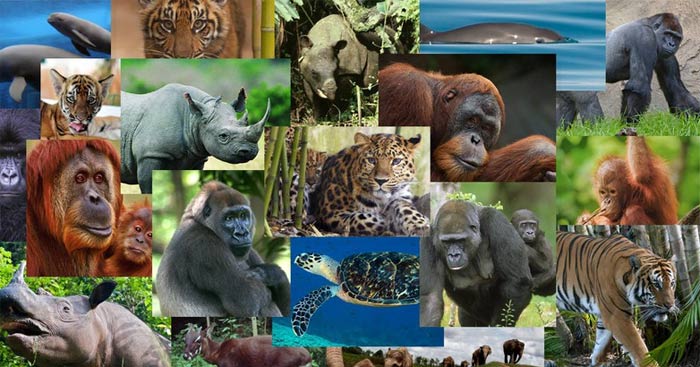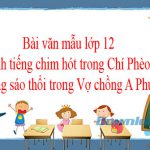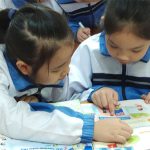Tiếng Anh 12 Unit 6: Skills, Skills tiếng Anh lớp 12 Unit 6 được biên soạn với nội dung bám sát theo chương trình SGK Tiếng Anh lớp 12 mới trang 10, 11, 12, 13,
Giải bài tập Skills Unit 6 lớp 12 giúp các em học sinh trả lời các câu hỏi tiếng Anh phần reading, speaking, listening, writing trang 10→14 để chuẩn bị bài Endangered Species – Các loài sắp tuyệt chủng trước khi đến lớp.
Skills tiếng Anh lớp 12 Unit 6 được biên soạn với nội dung bám sát theo chương trình SGK Tiếng Anh lớp 12 mới trang 10, 11, 12, 13, 14. Qua đó giúp các bạn học sinh nhanh chóng nắm vững được kiến thức, để học tốt Tiếng Anh 12. Vậy sau đây là nội dung chi tiết bài soạn tiếng Anh 12 Skills Unit 6, mời các bạn cùng theo dõi tại đây.
Xem Tắt
Reading
Saving endangered species: pros and cons
(Bảo vệ các loài gặp nguy hiểm: ưu và nhược điểm)
Câu 1
1. Discuss with a partner.
(Thảo luận với một người bạn)
Gợi ý đáp án
|
dolphin (cá heo) |
tiger (hổ) |
saola (sao la) |
|
elephant (voi) |
sea turtle (rùa biển) |
giant panda (gấu trúc) |
Gợi ý đáp án
a. Which of these animals are on the list of endangered species? (Những loài động vật nào nằm trong danh sách các loài có nguy cơ bị tuyệt chủng?)
=> Tigers, saolas, elephants, sea turtles, and giant pandas are on the list of endangered species.
(Hổ, sao la, voi, rùa biển và gấu trúc nằm trong danh sách các loài có nguy cơ bị tuyệt chủng.)
b. Can you find them in Vietnam now? (Hiện giờ bạn có thể tìm thấy chúng ở VN hiện nay không?)
=> Tigers, saolas, elephants and sea turtles are still found in Viet Nam, but each with a small population.
(Hổ, saola, voi và rùa biển vẫn còn được tìm thấy ở Việt Nam, nhưng mỗi loại đều số lượng nhỏ.)
Câu 2
Below are three people’s opinions posted on the fantasticwildlife.org website. Read the text and decide what they are talking about
(Dưới đây là ba ý kiến của người dân được đăng trên trang web fantasticwildlife.org. Đọc văn bản và quyết định những gì họ đang nói về)
A. Why endangered animals should be protected
(Tại sao động vật có nguy cơ bị tuyệt chủng cần được bảo vệ)
B. How to protect endangered species
(Làm thế nào để bảo vệ các loài có nguy cơ bị tuyệt chủng)
C. Whether or not we should protect endangered species
(Chúng ta có nên bảo vệ các loài có nguy cơ bị tuyệt chủng)
SIMON (Scotland)
Let’s just put ourselves in endangered animals’ shoes. How would we feel if the animals ruled the world and we became the ones in danger of extinction? We are living creatures and so are the animals. We can no longer attribute the rapid extinction of species to natural causes such as earthquakes or drought. Today many plants and animals are becoming endangered or extinct because of habitat destruction, overharvesting and poaching. It’s our duty to start repairing the damage we’ve caused to nature.
YOSHIKO (JAPAN)
If we continue to save endangered animals, then we stop animals from replacing other animals. Extinction is just a part of the evolutionary process and we must not interfere with it. Hence, trying to save species that cannot survive in their environment is rather silly, because it’s against the laws of nature. So, let mother nature do her job. What’s more, not all animals are friendly or harmless. Elephants and tigers are two examples of animals that are dangerous. People living near some nature reserves have to face constant threats to their livestock and crops. Then should we protect these animals at the expense of local people’s lives?
AI LIEN (Viet Nam)
Animal and plant extinction can ruin the ecosystem and reduce biodiversity. All creatures are part of an ecosystem. They all help humans in some way. For example, over 50% of the medicines currently in use are derived from natural products made from animals or plants. By losing biodiversity, we are losing the chance to discover new medicines that could save the lives of millions of people each year. What’s more, nature is beautiful, and that’s the best reason to preserve it. Walking in a rainforest or going scuba-diving over a coral reef helps us to relax and feel at peace.
Gợi ý đáp án
Đáp án: C. Whether or not we should protect endangered species.
Câu 3
Whose opinions are these? Write the correct name in the space before each statement.
(Những ý kiến này là của ai? Viết tên chính xác vào chỗ trống trước mỗi câu.)
Gợi ý đáp án
|
1. Ai Lien |
2. Yoshiko |
3. Simon |
|
4. Yoshiko |
5. Simon |
6. Ai Lien |
Câu 4
Find the prepositions in the reading text to complete these phrases and expressions. Use a dictionary to find their meanings.
Gợi ý đáp án
|
1. in |
2. to |
3. to |
4. with |
5. at |
Câu 5
Discuss with a partner.
(Thảo luận với một người bạn.)
Which of the three people above do you agree with? Why? (Bạn đồng ý với ai trong số 3 người trên? Tại sao?)
Gợi ý đáp án
I agree with SiMon (Scotland). Because, I think:
– We are living creatures and so are the animals.
– We can no longer attribute the rapid extinction of species to natural cause such as earthquakes or drought.
– Today many plants and animals are becoming endangered or extinct because of habitat destruction, over – harvesting and poaching. It’s our duty to start repairing the damage we’ve caused to nature.
Speaking
Câu 1
Action for endangered species conservation (Hành động để bảo tồn các loài quý hiếm)
Put the following ways of protecting rhinos and coral reefs in the correct boxes.
(Đặt những cách sau đây để bảo vệ tê giác và các rặng san hô vào các khung đúng.)
Gợi ý đáp án
* How to protect rhinos (Cách bảo vệ tê giác)
– ban transportation of and trading in rhino horns (cấm vận chuyển và kinh doanh sừng tê giác)
– donate to rhino conservation organisations (quyên góp cho các tổ chức bảo tồn tê giác)
– launch anti-poaching campaigns (khởi động các chiến dịch chống săn bắt trái phép)
– stop using rhino products (ngừng sử dụng các sản phẩm làm từ tê giác)
* How to protect coral reefs (Cách bảo vệ các rạn san hô)
– not leave litter on the beach or in the water (không vứt rác trên bãi biển hoặc xuống nước)
– practise safe and responsible diving and snorkelling (thực hành lặn biển an toàn và có trách nhiệm)
– use organic fertilizers to avoid polluting the ocean (sử dụng phân bón hữu cơ để tránh ô nhiễm đại dương)
– stop using coral reef products (ngừng sử dụng các sản phẩm từ rạn san hô)
Câu 2
Work with a partner. Use the information in 1 or your own ideas to prepare a talk about how to protect rhinos or coral reefs. The following phrases and expressions may help you.
(Làm việc cùng một người bạn. Sử dụng thông tin trong bài 1 hoặc ý tưởng riêng của mình để chuẩn bị cho một cuộc nói chuyện về làm thế nào để bảo vệ tê giác hoặc rạn san hô. Các cụm từ và các biểu thức sau đây có thể giúp bạn.)
Gợi ý đáp án
|
Purposes |
Phrases and expressions |
|
1. To welcome the audience and introduce the topic (Chào khán giả và giới thiệu chủ đề) |
Good morning/ afternoon, everyone. |
|
2. To introduce the first point/idea (Giới thiệu điểm/ ý tưởng đầu tiên) |
To begin with, I’ll suggest… |
|
3. To move to the next point (Để chuyển sang ý tiếp theo) |
My next point is… |
|
4. To indicate the end of the talk (Để kết thúc cuộc nói chuyện) |
Finally, I’d like to summarise the key issues/ points. |
|
5. To thank the audience (Để cảm ơn khán giả) |
Thank you for your attention. |
Câu 3
Present your talk to the class.
(Trình bày cuộc nói chuyện của bạn trước lớp.)
Gợi ý đáp án
Good morning everyone!
In today’s talk, I would like to present some ways to protect rhino populations. You know, rhinos are at risk of being extinct due to massive poaching for horns because in some countries, especially Asian ones, it’s believed that rhino horns are able to treat chronic diseases such as cancer. That’s why more and more people are willing to spend a lot of money buying rhino horns or powder from their horns. Recently, customs officers at Noi Bai International Airport, Vietnam, have confiscated hundreds of kilos of rhino horns from an unknown dealer. This is only one of the cases that were detected regarding rhino horn trade. To address this atrocity, I would first suggest there should be serious methods of punishment for the transport and trade of rhino horns. The conservation and expansion of rhino species usually costs a lot of money. So luckily there is an easy and practical way to protect rhinos, which is to donate money to rhino conservation organizations. But we should go a step further and should launch anti-poaching campaigns that motivate people to stop hunters and dealers from hunting and trading rhino horns. Lastly, to protect rhinos we need to improve people’s awareness and knowledge. There should be more scientific evidence dispersed showing that rhino horn powder doesn’t help in curing diseases and people should therefore no longer use rhino products.
To sum up, these are four among numerous ways to protect rhinos from extinction.
Thank you for listening.
Listening
Dangers to wildlife (Nguy hiểm đến động vật hoang dã)
Câu 1
Below is the conservation status scale which indicates whether a species still exists and how likely it is to become extinct in the near future. Match the three phrases indicating three threatened’ levels with the numbers 1,2 and 3.
(Dưới đây là tình trạng bảo tồn quy mô cho ta biết liệu một loài có còn tồn tại hay không và khả năng nó sẽ biến mất trong tương lai như thế nào . Nối 3 cụm từ chỉ 3 mức đe doạ với các số 1,2,3)
Gợi ý đáp án
1. CR (critically endangered) (có nguy cơ tuyệt chủng trầm trọng)
2. EN (endangered) (có nguy cơ tuyệt chủng)
3. VU (vulnerable) (dễ bị tổn thương)
Câu 2
Listen to the first part of a talk given by Peter Shawl, a conservation biologist, and check your answers in 1.
(Nghe phần đầu tiên của cuộc nói chuyện của Peter Shawl, một nhà bảo tồn sinh học , và kiểm tra câu trả lời của bạn trong 1.)
Audio Script:
Hello everyone. I’m happy that you could come and listen to my talk today. I’ll be discussing two main points. To begin with, I’d like to explain the conservation status scales. Now look at the scale. Let’s start from the right end. When an animal is ranked as “Least concern” and “Near threatened”, it isn’t endangered now. But it might be in the near future. Next is “Vulnerable”, which means the animals faces a high risk of ectinction. “Endangered” means a very high risk, and “Critically endagered” means an extremely high risk. Species classified as VU, EN or CR need care and protection. The last two groups, EW and EX, tell us that the species is not found in the wild of has become extinct.
Gợi ý đáp án
|
1. CR |
2. EN |
3. VU |
Câu 3
Listen to the second part of the talk and choose the best option to complete the statements or answer the questions.
(Nghe phần thứ hai của buổi nói chuyện và chọn lựa chọn tốt nhất để hoàn thành các nhận định hoặc trả lời các câu hỏi.)
1. According to Peter Shawl, wildlife becomes endangered because ____________________.
A. the population of some species grow too fast
B. natural habitats are destroyed by humans
C. the stronger animals kill the weaker
2. Animals’ habitats become polluted when humans ____________________.
A. cut down forest trees
B. build more houses
C. use chemicals in agriculture
3. When tigers are hunted and killed, which of their parts are collected and used?
A. Their bones.
B. Their fur.
C. Their teeth.
4. Which of the following uses of elephant tusks is mentioned in the talk?
A. Making false teeth.
B. Producing traditional medicine to treat diseases.
C. Making valuable items.
Gợi ý đáp án
|
1. B |
2. C |
3. A |
4. C |
1. According to Peter Shawl, wildlife becomes endangered because natural habitats are destroyed by humans
(Theo Peter Shawl, động vật hoang dã trở nên bị đe dọa vì môi trường sống tự nhiên bị phá hủy bởi con người.)
2. Animals’ habitats become polluted when humans use chemicals in agriculture.
(Môi trường sống của động vật bị ô nhiễm khi con người sử dụng hóa chất nông nghiệp)
3. When tigers are hunted and killed, which of their parts are collected and used?
(Khi hổ bị săn bắt và giết, phần nào của họ được thu thập và sử dụng?)
=> Their bones. (xương của chúng.)
4. Which of the following uses of elephant tusks is mentioned in the talk?
(Việc sử dụng ngà voi nào sau đây được đề cập trong cuộc nói chuyện?)
=> Making valuable items. (Làm các đồ vật có giá trị.)
Câu 4
Listen to the second part again. Complete the summary of the talk, writing one word in each blank.
(Nghe phần thứ hai một lần nữa. Hoàn thành bản tóm tắt của bài nói, viết một từ trong mỗi khoảng trống.)
Gợi ý đáp án
|
1. dangers |
2. habitat |
3. poaching |
|
4. human |
5. conserve |
Câu 5
Do you agree with Peter Shawl that humans are responsible for the loss of biodiversity? Discuss with a partner.
(Bạn có đồng ý với Peter Shawl rằng con người phải chịu trách nhiệm cho sự mất mát đa dạng sinh học? Thảo luận với một người bạn.)
Gợi ý đáp án
I agree with Peter Shawl that humans are responsible for the loss of biodiversity.
Because:
People cut down forest trees to make more room for land for agriculture and building housing. To increase crop production, people may also use pesticides and fertilizers. As a result, wild animals’ natural living space gets smaller and more polluted. The second danger is hunting and poaching. Animals can be killed not just for food, but for other purposes. In many Asian countries, tiger bones and rhino horns are believed to be able to treat diseases while elephant tusks are used to make valuable ivory objects.
Writing
Câu 1
Endangered species report (Báo cáo loài gặp nguy hiểm)
Match the pictures with the animals’ names. Then discuss the questions with a partner.
(Nối những hình ảnh với tên của các loài động vật. Sau đó thảo luận câu hỏi với một người bạn.)
Can you find these animals in Viet Nam?
(Bạn có thể thấy những động vật này ở Việt Nam không?)
What do they eat?
(Chúng ăn gì?)
Are they endangered species?
(Chúng có phải là loài có nguy cơ bị tuyệt chủng không?)
a. blue whale
(cá voi xanh)
b. Komodo dragon
(rồng Komodo)
Gợi ý đáp án
1. b (Komodo dragon: not found in Viet Nam; eats meat; classified as vulnerable)
(Rồng Komodo: không tìm thấy ở Việt Nam; ăn thịt; được xếp vào loại dễ bị tổn thương)
2. a (blue whale: sometimes found stranded on Viet Nam’s coastal areas; eats small shellfish; classified as endangered)
(cá voi xanh: đôi khi được tìm thấy bị mắc kẹt ở các vùng biển của Việt Nam; ăn các loại động vật có vỏ nhỏ, được xếp vào nhóm có nguy cơ bị tuyệt chủng)
Câu 2
Read the facts about the Komodo dragon and the blue whale. Write a, b, c, d, or e in the space provided to match the title with the correct section.
(Đọc sự kiện về con rồng Komodo và cá voi xanh. Viết a, b, c, d, hay e vào chỗ trống được cung cấp để phù hợp với tiêu đề với các phần chính xác.)
Câu 3
Choose one of the two species in 2 and write a report of 150-200 words to describe it. Follow the plan below.
(Chọn một trong hai loài trong 2 và viết một báo cáo trong 150-200 từ để mô tả nó. Thực hiện theo kế hoạch dưới đây.)
Paragraph 1: Habitat and location of the species below.
Example: Komodo dragons are found in the wild …
They live in forests, …
Paragraph 2: Physical features and diet
Example: Although they are called dragons, they look like …
Paragraph 3: Population and conservation status
Example: There are about 6,000 … According to the IUCN Red List, Komodo dragons are classified as …
Gợi ý đáp án
Komodo dragons are found in the wild on only five islands in Indonesia: Komodo, Rinca, Gili Montang, Gili Dasami and Flores, where they roam freely. They live mainly in forests, but can be seen scattered widely over the islands from beaches to hilltops.
Though they are called dragons, they look like a big lizard. A male adult can measure three metres in length and weighs 90 kilos. Komodo dragons eat meat. They are also fierce hunters and an eat very large prey, such as large water buffaloes, deer and pigs. They will even eat smaller Komodo dragons.
There are about 6,000 Komodo dragons in Indonesia. Humans are not a great danger to them. However, their population is slightly declining because there are more males than females. According to the IUCN Red List, Komodo dragons are not endangered, but are considered vulnerable. About 30 zoos outside Indonesia Tave been trying to protect the Komodo. There are also plans to hald more wildlife parks around the world, which will help to rcrease the population of this fascinating species.










